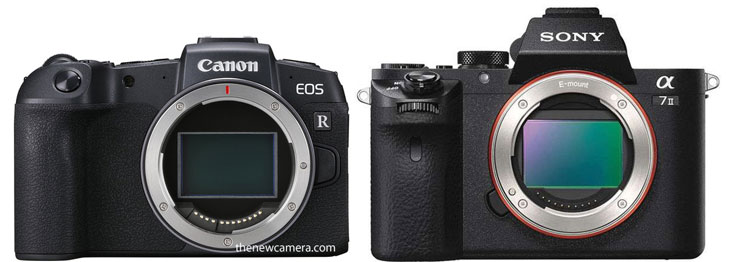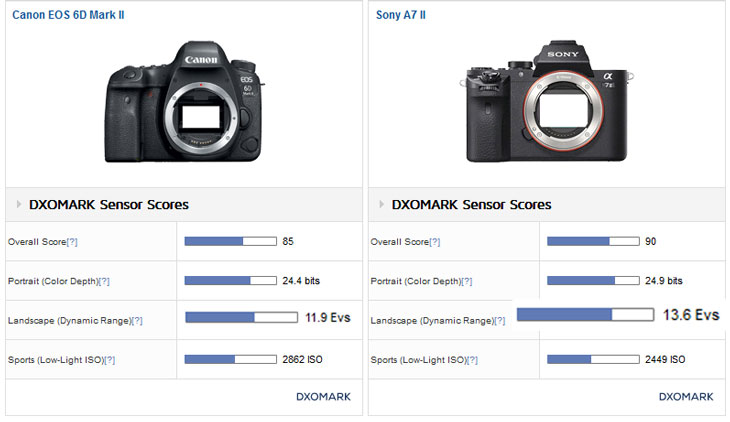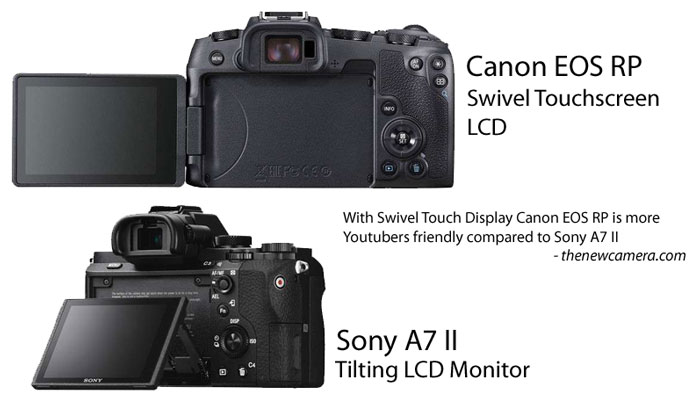
We are doing a specification comparison review between Canon EOS RP vs Sony A7 II, to tell you the name of best camera in between the Canon EOS RP vs Sony A7 II
Price Difference between – Canon EOS RP vs Sony A7 II
| Canon EOS RP | Sony A7 II |
| $1299 [Body Price] Amazon.com | B&H | $998 [Body Price] Amazon.com | B&H |
Now its specification comparison time, we are comparing the specification of Canon EOS RP camera with with the Ultra Popular and still one of the best selling Fullframe Mirrorless camera the Sony A7 II.
So, let’s begin, take a look at the details in comparison sheet of both the camera. We are comparing every possible specification that may effect your choice of preference.
| Camera Name | Canon EOS RP | Sony A7 II | ||
| Pixels | Actual: 27.1 Megapixel Effective: 26.2 Megapixel |
Actual: 24.7 Megapixel Effective: 24.3 Megapixel |
||
| Tech | CMOS | Exmor CMOS | ||
| Aspect Ratio | 3:2, 4:3, 16:9 | 3:2, 16:9 | ||
| Sensor Size | 35.9 x 24 mm | 35.8 x 23.9 mm | ||
| File Formats | Still Images: JPEG, RAW Movies: AVC/H.264, MP4 Audio: AAC, Linear PCM |
Still Images: JPEG, RAW Movies: AVCHD 2.0, XAVC S Audio: AAC LC, Dolby Digital 2ch, Linear PCM (Stereo) |
||
| Bit Depth | 14-Bit | 14-Bit | ||
| Dust Reduction System | Yes | Yes | ||
| Memory Card Type | SD SDHC SDXC |
SDXC SDHC SD Memory Stick PRO Duo (High Speed) Memory Stick PRO HG-Duo Memory Stick XC-HG Duo |
||
| Image Stabilization | Digital, 5-Way | Sensor-Shift, 5-Way |
As we all know that Canon EOS RP uses the same sensor as of Canon 6D Mark II camera. So, expecting a better dynamic range from Canon 6D Mark II as we have in Sony A7 II isn’t fair.

What actually improved from Canon 6D Mark II vs Sony A7 II ? By the Introduction of new DIGIC 8 image processor the Canon also implemented new noise processing algorithms with the camera. So, the noise of the camera is bit more controlled compared to Canon 6D Mark II.
Exposure and more…
| Exposure Control | |||
| Canon EOS RP | Sony A7 II | ||
| ISO Sensitivity | Auto, 100 to 40000 (Extended Mode:50 to 102400) | 100 to 25600 (Extended Mode:50 to 25600) | |
| Shutter | 30 to 1/4000 Second , Bulb Mode | Type: Electronic & Mechanical Speed: 1/8000 to 30 Second , Bulb Mode |
|
| Exposure Modes | Modes: Aperture Priority, Manual, Program, Shutter Priority Metering Range: EV -3.0 to EV 20.0 Compensation: -3 EV to +3 EV (in 1/3, 1/2 EV Steps) |
Modes: Aperture Priority, Auto, Manual, Programmed Auto, Scene Selection, Shutter Priority, Sweep Panorama Metering Range: EV -1.0 to EV 20.0 Compensation: -5 EV to +5 EV (in 1/3 or 1/2 EV Steps) |
|
| Buffer/Continuous Shooting | Up to 5 fps at 26.2 MP for Unlimited Frames in JPEG Format Up to 5 fps at 26.2 MP for up to 50 Frames in Raw Format |
Up to 5 fps at 24 MP for up to 50 Frames | |
As you can see Canon EOS RP features extended ISO range compared to Sony A7 II Camera. Canon EOS RP features ISO range starting from 100-40,000 in standard Range and 50-102400 in Extended Range.
Whereas, Sony A7II camera features Standard ISO range from 100-25600 and you also have a option to push your ISO range to ISO 50.
In general more ISO range means better low-light performance. But with Sony A7 II camera you are also getting 5 axis Image stabilization system. So, when you are shooting in low light environment you can hit more lower shutter speed (upto 5 stop) when compared to Canon EOS RP camera.
One of the best thing is you don’t have to worry about a bit while using Prime lenses or third party lenses with your camera. Since, image stabilization will help you all the time despite of type of lenses you are using.
4K Video – Canon EOS RP vs Sony A7 III
| AV Recording | ||||
| Video Recording | Yes | Yes | ||
| Video Format | 3840 x 2160p at 23.98/25 fps (MP4 via H.264) 1920 x 1080p at 25/29.97/50/59.94 fps (60 Mb/s MP4 via H.264) 1280 x 720p at 25/29.97/50/59.94 fps (12 Mb/s MP4 via H.264) |
1920 x 1080p at 24/30/60 fps (50 Mb/s XAVC S) 1920 x 1080p at 60 fps (28 Mb/s AVCHD) 1920 x 1080i at 60 fps (24 Mb/s AVCHD) 1920 x 1080i at 60 fps (17 Mb/s AVCHD) 1920 x 1080p at 24 fps (24 Mb/s AVCHD) 1920 x 1080p at 24 fps (17 Mb/s AVCHD) 1440 x 1080 at 30 fps (12 Mb/s MP4) 640 x 480 at 30 fps (3 Mb/s MP4) |
||
| Output | MP4 | MP4, XAVC S, S-Log2 | ||
| Video Clip Length | Up to 29 Minute 59 Second | Up to 29 Minutes | ||
| Audio Recording | Built-In Mic: With Video (Stereo) | Built-In Mic: With Video (Stereo) | ||
Canon EOS RP camera can record Videos in 4K whereas the Sony A7II camera limited to Full HD video recording mode only.
But Keep in Mind the Canon EOS RP Camera have some issues in 4K video recording mode
Limitations of Canon EOS RP in 4K Mode
- Canon EOS RP uses the APS-C Portion of the sensor, so you will be getting very limited dynamic range
- Canon EOS RP camera 4K video mode suffers from 1.6X Crop factor.
- Canon EOS RP camera doesn’t have DPAF support when you are recording 4K videos.
Limitation of Canon EOS RP camera in Full HD Video Mode
In Canon EOS RP camera is missing 24p frame option in Full HD and HD recording mode.
Sony A7 II Camera doesn’t miss any standard recording option in Full HD video mode.
At the same time Sony A7 II camera 24 MP BSI CMOS Video Dynamic range is better compared to Canon EOS RP 26MP CMOS camera.
8Bit output with S-Log2 whereas Canon EOS RP has 8bit output without C-log.
DPAF vs HYBRID – Auto Focus
| Focus Control | |||
| Focus Type | Auto & Manual Focus | Auto & Manual Focus | |
| Continuous Focus | Continuous AF upto 3 FPS | Continuous AF upto 5 FPS | |
| Autofocus Points | Phase Detection: 4779 | Phase Detection: 117 Contrast Detection: 25 |
|
Canon clearly have a upper hand in the specs sheet while mentioning their EOS RP camera carry have more than 4K AF area zones or segments.
So, it’s very clear that Canon will have more AF screen coverage .
Fastest Camera – Canon EOS RP or Sony A7 II ?
Canon EOS RP camera fails to give Continuous AF support at 5FPS more, Continuous AF starts from 3 FPS and Subject tracking goes down upto 2.6 FPS.
Sony A7 II camera features Continuous shooting speed 5 FPS full time AF support and very accurate Eye AF support while recording videos.

Which one has better Display ?
| Viewfinder/Display | |||
| Viewfinder Type | Electronic | Electronic | |
| Viewfinder Size | 0.39″ | 0.5″ | |
| Viewfinder Pixel Count | 2,360,000 | 2,359,296 | |
| Viewfinder Eye Point | 22.00 mm | 27.00 mm | |
| Viewfinder Coverage | 100% | 100% | |
| Viewfinder Magnification | Approx. 0.70x | Approx. 0.71x | |
| Diopter Adjustment | -4 to +1 m | -4 to +3 m | |
| Display Screen | 3″ Rear Screen Swivel Touchscreen LCD (1,040,000) | 3″ Tilting LCD (1,228,800) | |
| Screen Coverage | 100% | 100% | |
Canon EOS RP camera features better touch screen and viewfinder, compared to Sony A7II camera.
Other Features
Sony A7 II camera features better battery life (100+ shots), You will be also getting Environmental sealing with Sony A7 II camera. No weather sealing in Canon EOS RP.
Comparatively if we talk about list of lenses available, then we don’t have more than 10 lenses for Canon EOS RF Mount camera at the time I am writing this post. Whereas, Sony A7II camera have 100+ lenses out there specifically made for Sony FE Mount cameras.
Verdict:
For Hybrid Shooters we have no option other than Canon EOS RP, nature of display Canon EOS RP is more user friendly compared to Sony A7 II. For still shooters we recommend Sony A7 II camera, since the camera features better dynamic range, In-body 5 axis Image Stabilization system and better continuous drive.
Canon EOS RP $1299 [Body Price] Amazon.com | B&H
Sony A7 II $998 [Body Price] Amazon.com | B&H







Isn’t the 7II an older model? I think the 7III is out. Are you comparing price to price? Shouldn’t you do latest to latest?
Yes we are comparing camera falling on same price range
There’s weather sealing on the RP, check the specs again.
No weather sealing in RP, Only Sony A7 provides weather sealing.
Dynamic range on A7II kicks RP any day. Guess you are just comparing on paper.
AF for Sony is also better. May be you should see YouTubers review of this.
That’s I have said too. Dynamic range of Sony A7 II is better.
With Canon you are getting more AF coverage area, but with Sony you are getting more faster AF. Sony support continuous AF in 5FPS mode whereas the Canon remains limited to 3FPS.